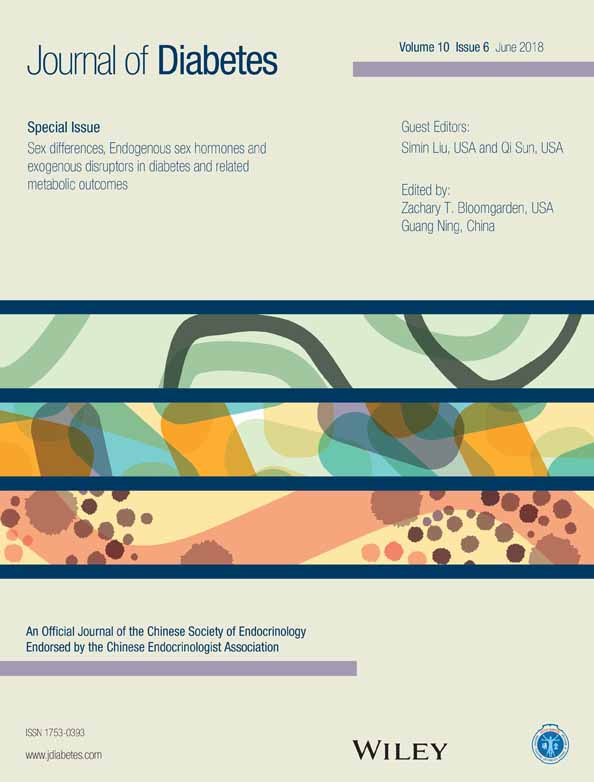Serum adipocyte fatty acid-binding protein levels are associated with peripheral arterial disease in women, but not men, with type 2 diabetes mellitus
血清脂肪细胞型脂肪酸结合蛋白水平与女性而不是男性2型糖尿病患者的外周动脉疾病相关
Abstract
enBackground
Adipocyte fatty acid-binding protein (A-FABP) has been recognized as an important player in macrophage cholesterol trafficking and inflammation, and may promote the development of atherosclerosis. To further elucidate the role of A-FABP in atherosclerosis in diabetes, we investigated the relationship between serum A-FABP concentrations and peripheral arterial disease (PAD) in patients with type 2 diabetes mellitus (T2DM).
Methods
In all, 488 inpatients with T2DM were enrolled in the study (254 men, 234 women; mean (±SD) age 57.3 ± 13.0 years). The severity of peripheral arterial stenosis was assessed by ultrasound examination. Serum A-FABP concentrations were determined by ELISA.
Results
Serum A-FABP concentrations were significantly higher in patients with than without PAD (8.0 ± 3.3 vs 6.2 ± 1.6 ng/mL, respectively; P < 0.05). Interestingly, there was an obvious gender-related difference in PAD patients with T2DM, with the stenosis rate being higher for female than male T2DM patients in the third A-FABP tertile. Logistic regression analysis revealed that serum A-FABP concentrations were an independent risk factor for PAD in female T2DM patients (odds ratio 1.890, 95% confidence interval 1.041–3.432; P = 0.036), but not in male T2DM patients. Correlation analyses revealed that A-FABP concentrations were correlated with body mass index (BMI), diastolic blood pressure, urinary microalbumin, and serum creatinine in male patients, and with BMI, duration of T2DM, fasting blood glucose, and serum creatinine in female patients.
Conclusions
Serum A-FABP concentrations are closely associated with PAD in Chinese women with T2DM. The study findings suggest that A-FABP may be a more specific marker of PAD in diabetic women than men.
摘要
zh背景
脂肪细胞型脂肪酸结合蛋白(adipocyte fatty acid-binding protein, A-FABP)已被证实在巨噬细胞胆固醇转运和炎症中扮演重要角色, 有可能促进动脉粥样硬化的发展。为进一步阐明A-FABP在糖尿病动脉粥样硬化中的作用, 本研究观察了2型糖尿病患者血清A-FABP水平与外周动脉疾病(peripheral arterial disease, PAD)之间的关系。
方法
本研究共纳入488例2型糖尿病患者(男254例, 女234例, 平均年龄, 57.3 ± 13.0岁)。超声检查评估外周动脉狭窄的严重程度, 酶联免疫法(ELISA)测定血清A-FABP水平。
结果
与非PAD患者比较, PAD患者血清A-FABP水平显著增高(分别是8.0 ± 3.3 ng/mL vs. 6.2 ± 1.6 ng/mL, P < 0.05)。本研究发现A-FABP在PAD糖尿病患者中有明显的性别差异, A-FABP第三分位数的女性糖尿病患者与男性相比有较高的PAD狭窄率。此外, logistic回归分析显示血清A-FABP水平在女性糖尿病患者是PAD的一个独立危险因素(OR 1.890, 95% CI:1.041-3.432, P = 0.036), 而在男性中没有相关性。相关分析显示A-FABP水平在男性患者中与体重指数(body mass index, BMI)、舒张压、尿微量白蛋白和血清肌酐具有相关性, 而在女性患者中与BMI、2型糖尿病病程、空腹血糖和血清肌酐相关。
结论
血清A-FABP水平与伴有PAD的中国2型糖尿病女性患者密切相关。本研究提示, 与男性相比, A-FABP是女性2型糖尿病患者发生PAD更为特异的标志物。




